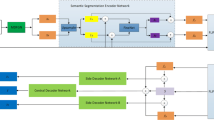Abstract
In this paper, we propose a novel multiple description image coding (MDC) method,which can be called adaptive reconstruction based multiple description coding with randomly offset quantizations (ARMDROQ). In this scheme, two prediction modes are proposed, which are be defined as mode 1 and mode 2 respectively. Specifically, in the proposed ARMDROQ scheme, the input image is partitioned into M subsets and obtaining M descriptions. Then one subset of each description is encoded and decoded directly, while others are predicted encoded and decoded by using adaptive prediction modes. The experimental results show that the proposed scheme achieves better performance than other existing methods.














Similar content being viewed by others
References
Bai H, Lin W, Zhang M, Wang A, Zhao Y (2014) Multiple description video coding based on human visual system characteristics. IEEE Trans Circuits Syst Video Technol 24(8):1390–1394
Bai H, Zhu C, Zhao Y (2007) Optimized multiple description lattice vector quantization for wavelet image coding. IEEE Trans Circuits Syst Video Technol 17 (7):912–917
Goyal VK (2001) Multiple description coding: compression meets the network. IEEE Signal Process Mag 18(5):74–93
Jayant NS (1981) Subsampling of a DPCM speech channel to provide Two Self-Contained Half-Rate channels. Bell Labs Tech J 60(4):501–509
Jayant N, Christensen S (1981) Effects of packet losses in waveform coded speech and improvements due to an odd-even sample-interpolation procedure. IEEE Trans Commun 29(2):101–109
Jiang W, Ortega A (1998) Multiple description coding via polyphase transform and selective quantization. In: Visual communications and image processing’99, vol 3653, International Society for Optics and Photonics, pp 998–1009
Kazemi M, Iqbal R, Shirmohammadi S (2017) Redundancy allocation based on the weighted mismatch-rate slope for multiple description video coding. IEEE Trans Multimedia 19(1):54–66
Lin C, Tillo T, Zhao Y, Jeon B (2011) Multiple description coding for H. 264/AVC with redundancy allocation at macro block level. IEEE Trans Circuits Syst Video Technol 21(5):589–600
Lin C, Zhao Y, Tillo T, Xiao J (2015) Multiple description coding for stereoscopic videos with stagger frame order. IEEE Trans Circuits Syst Video Technol 25(6):1016–1025
Meng L, Liang J, Samarawickrama U, Zhao Y, Bai H, Kaup A (2014) Multiple description coding with randomly and uniformly offset quantizers. IEEE Trans Image Process 23(2):582–595
Meng L, Liang J, Zhao Y, Bai H, Lin C, Kaup A (2013) M-channel multiple description coding based on uniformly offset quantizers with optimal deadzone. In: 2013 IEEE international conference on acoustics, speech and signal processing (ICASSP). IEEE, pp 2026–2030
Miguel AC, Mohr AE, Riskin EA (1999) SPIHT for generalized multiple description coding. In: 1999 international conference on image processing, 1999. ICIP 99. Proceedings, vol 3, IEEE, pp 842–846
Sun G, Samarawickrama U, Liang J, Tian C, Tu C, Tran TD (2009) Multiple description coding with prediction compensation. IEEE Trans Image Process 18(5):1037–1047
Samarawickrama U, Liang J, Tian C (2010) M-channel multiple description coding with two-rate coding and staggered quantization. IEEE Trans Circuits Syst Video Technol 20(7):933–944
Samarawickrama U, Liang J, Tian C (2011) A three-layer scheme for M-channel multiple description image coding. Signal Process 91(10):2277–2289
Tian C, Hemami SS (2005) A new class of multiple description scalar quantizer and its application to image coding. IEEE Signal Process Lett 12(4):329–332
Tillo T, Grangetto M, Olmo G (2007) Multiple description image coding based on Lagrangian rate allocation. IEEE Trans Image Process 16(3):673–683
Vaishampayan V (1993) Design of multiple description scalar quantizers. IEEE Trans Inf Theory 39(3):821–834
Wang Y, Orchard MT, Vaishampayan V, Reibman AR (2001) Multiple description coding using pairwise correlating transforms. IEEE Trans Image Process 10 (3):351–366
Wang Y, Reibman AR, Orchard MT, Jafarkhani H (2002) An improvement to multiple description transform coding. IEEE Trans Signal Process 50(11):2843–2854
Xiao J, Tillo T, Zhao Y (2013) Real-time video streaming using randomized expanding ReedCSolomon code. IEEE Trans Circuits Syst Video Technol 23(11):1825–1836
Zong J, Meng L, Tan Y, Ren Y (2016) Perceptual multiple description coding with randomly offset quantizers. In: Signal and information processing association annual summit and conference (APSIPA), 2016 Asia-Pacific, IEEE, pp 1–5
Acknowledgements
The work is partially supported by the National Natural Science Foundation of China (No. 61402268, 61401260, 61373081, 61401408, 61572298, 61601269, 61602285, 61601268), the Technology and Development Project of Shandong (No. 2013GGX10125), the Natural Science Foundation of Shandong China (No.BS2014DX006, ZR2014FM012, ZR2015PF006, ZR2016FB12) and the Taishan Scholar Project of Shandong, China.
Author information
Authors and Affiliations
Corresponding author
Rights and permissions
About this article
Cite this article
Zong, J., Meng, L., Tan, Y. et al. Adaptive reconstruction based multiple description coding with randomly offset quantizations. Multimed Tools Appl 77, 26293–26313 (2018). https://doi.org/10.1007/s11042-018-5857-0
Received:
Revised:
Accepted:
Published:
Issue Date:
DOI: https://doi.org/10.1007/s11042-018-5857-0




